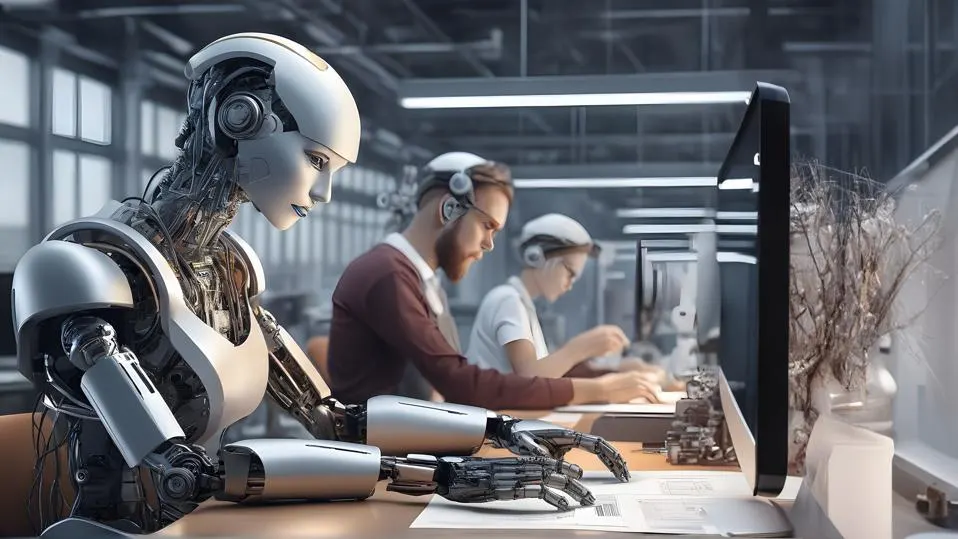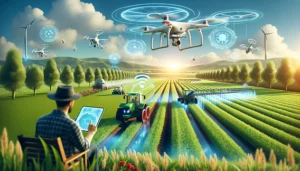“AI and Robots: A Technological Revolution”
Introduction
The integration of artificial intelligence (AI) and robotics represents a significant leap in technological advancement, revolutionizing various sectors and shaping the future in unprecedented ways. AI and robots are not just science fiction anymore; they are real and they are transforming our world. This article explores “AI and Robots: A Technological Revolution,” delving into their evolution, applications, innovations, ethical considerations, and future implications.
The Evolution of AI and Robotics
- A Brief History of AI and Robotics
The journey of AI and robotics began decades ago, with early developments in computer science and mechanical engineering laying the groundwork. The term “artificial intelligence” was coined in 1956 by John McCarthy, marking the start of a new era in computing.. Meanwhile, robotics saw significant progress with the invention of the Unimate, the first industrial robot, in 1961. This robot revolutionized manufacturing, setting the stage for future advancements.
- Milestones in AI and Robotics Development
Over the years, AI and robotics have achieved numerous milestones.AI was seen as having capability when in 1997 IBM’s Deep Blue defeated Chess Grandmaster Garry Kasparov. The 21st century brought advancements like the development of self-driving cars by Google, AI-powered virtual assistants like Siri and Alexa, and groundbreaking robots like Boston Dynamics’ Spot. These milestones highlight the incredible progress made, underscoring the theme of “AI and Robots: A Technological Revolution.”
Transformative Applications
- AI in Healthcare: Revolutionizing Patient Care
AI’s impact on healthcare is profound, revolutionizing patient care through enhanced diagnostics, personalized treatment plans, and efficient administrative processes. AI algorithms can analyze medical data to detect diseases early, predict patient outcomes, and recommend personalized treatment options. The surgical systems of Robotics surgeries including the da vinci surgical method of surgery provide very precise minimal invasive surgery. These advancements improve patient outcomes and streamline healthcare delivery, demonstrating the transformative power of “AI and Robots: A Technological Revolution.”
- Robotics in Manufacturing: Efficiency and Precision
This paper sought to establish that the manufacturing industry has immensely benefited from incorporation of robotics.. Robots have taken over repetitive, dangerous, and precision-demanding tasks, enhancing efficiency and safety. Cobots are those robots which are designed to share the industrial floors with the employees and provide the maximum support possible. With AI, these robots can learn and adapt to new tasks, further increasing their utility. The implementation of robotics in manufacturing exemplifies how “AI and Robots: A Technological Revolution” is reshaping industries for the better.

- AI and Robots in Everyday Life: Smart Homes and Assistants
AI and robots have become integral parts of everyday life, especially in the form of smart home devices and virtual assistants. AI-powered devices like thermostats, security systems, and lighting control enhance convenience and energy efficiency. Virtual assistants such as Amazon’s Alexa and Google Assistant provide information, manage schedules, and control smart home devices through voice commands. These innovations highlight how “AI and Robots: A Technological Revolution” is making our daily lives more efficient and interconnected.
Technological Innovations
- Breakthroughs in AI Algorithms and Machine Learning
One of the most significant aspects of AI and robotics is the continuous innovation in algorithms and machine learning techniques. Machine learning in general and specifically deep learning methods have made it possible for computers to make pattern recognition and pattern decisions with high levels of precision. Natural language processing (NLP) advancements have improved human-computer interactions, allowing for more intuitive and efficient communication. These breakthroughs are driving the capabilities of AI and robotics to new heights, embodying the essence of “AI and Robots: A Technological Revolution.”
- Advancements in Robotic Engineering
Robotic engineering has also seen substantial advancements, with robots becoming more agile, versatile, and intelligent. Innovations in materials science and mechanical design have led to the development of robots that can perform complex tasks in various environments. Autonomous drones, robotic exoskeletons, and advanced prosthetics are examples of how robotic engineering is enhancing human capabilities and exploring new frontiers.
Ethical Considerations
- Walking the Fairytale of Ethical AI & Robotics
In particular, the need for ethical issues ascends as the technologies such as AI and robotics develop persistently. The aforementioned points like data privacy, a biased algorithm, displacement of workers, and so on are to be discussed.. Ensuring that AI systems are transparent, fair, and accountable is crucial for building trust and promoting ethical use. The ethical landscape of AI and robotics must be navigated carefully to ensure that the benefits of “AI and Robots: A Technological Revolution” are realized without compromising societal values.
- Ensuring Responsible Use of AI and Robots
Responsible use of AI and robots involves creating guidelines and regulations that promote safety, fairness, and accountability. Organizations and governments must collaborate to establish standards for AI development and deployment. Public awareness and education are also essential to foster understanding and acceptance of these technologies. By ensuring responsible use, we can harness the full potential of “AI and Robots: A Technological Revolution” under the following risks and ethical dilemmas as follows.
Future Implications

- The Future of Work: Soft skills and Ten commandments of AI and Robots in the Workforce
The integration of AI and robots in the workforce is set to transform the future of work. While automation may replace certain tasks, it will also create new opportunities and job roles. AI can enhance productivity, enable more flexible working environments, and support decision-making processes. Preparing the workforce for this transition through education and training is crucial to maximize the benefits of “AI and Robots: A Technological Revolution” and ensure a smooth adaptation to these changes.
- AI and Robotics in Space Exploration
AI and robotics are playing a pivotal role in space exploration, enabling missions that push the boundaries of human knowledge. Autonomous robots and rovers, such as NASA’s Perseverance, are exploring distant planets and gathering valuable data. AI algorithms assist in mission planning, navigation, and data analysis, making space exploration more efficient and effective. The potential for AI and robotics to revolutionize space exploration exemplifies the far-reaching impact of “AI and Robots: A Technological Revolution.”
Conclusion
In conclusion, “AI and Robots: A Technological Revolution” is transforming various aspects of our world, from healthcare and manufacturing to everyday life and space exploration. The continuous evolution of AI algorithms and robotic engineering, coupled with responsible and ethical considerations, will shape a future where AI and robots play an integral role in enhancing human capabilities and advancing technological progress. Embracing this revolution is essential for harnessing its potential and ensuring a prosperous and innovative future.
FAQs
Q. What questions can be asked about the implications of using AI and robots?
Accessibility issues include data privacy, potential bias with algorithms and jobs automatization. Thus, it is critical to maintain transparency and non bias and FDA accountability in their artificial intelligence systems.
Q. How are AI and robots improving healthcare?
AI and robots are revolutionizing healthcare by enhancing diagnostics, personalizing treatment plans, and assisting in surgeries. AI algorithms can analyze medical data to detect diseases early, while robotic systems like surgical assistants improve precision and reduce recovery times for patients.
Q. What do you perceive as the ethical issues related to Artificial Intelligence and robots?
Three main ethical issues include data privacy, bias in algorithms and damaging impact to employment. When it comes to artificial intelligence transparency, fairness, and accountability must remain inalienable priorities.
Q. How are AI and robots being used in everyday life?
AI and robots are becoming part of our daily lives through smart home devices, virtual assistants, and autonomous vehicles. They help with tasks like managing schedules, controlling home appliances, and providing personalized recommendations, making life more convenient and efficient.
Q. What is the future of AI and robotics?
The future of AI and robotics is promising, with advancements expected in areas like autonomous systems, human-robot collaboration, and space exploration. Continuous innovation will lead to more intelligent, adaptable, and capable robots, further enhancing various industries and improving quality of life.














Post Comment